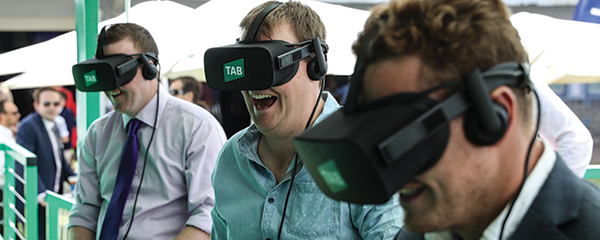OVER 10,000 PARTICIPANTS…
WHAT WE’VE LEARNED FROM VIRTUAL REALITY ACTIVATIONS
There is no doubt Virtual Reality is one of the big tech trends, one area where VR technology is having a huge impact is Marketing Activations, Events and Sponsorship. The hugely immersive and interactive nature of VR has enabled Sporting Teams, Brands and Rights Holders to engage consumers and create memorable experiences like never before.
At Catalyst we’ve worked on some brilliant VR activations developing content and technology solutions enabling consumers to participate in Virtual Reality activations as part of Big Bash Cricket, Taste of Melbourne and with brands including Moet Hennessy and TAB.

AFTER ENGAGING OVER 10,000 PARTICIPANTS IN VIRTUAL REALITY ACTIVATIONS THESE ARE THE NINE BIG THINGS WE’VE LEARNED;
1. It’s all still so new!
Virtual Reality has generated so much publicity it would be impossible not to have seen, read or heard about VR. But the reality is very few people have actually used a VR headset – for almost every participant across all the events and activations we’ve run its usually the first time they have used a VR headset. This partly why it is so interesting and so exciting.
2. Make it multi-sensory add participation.
While a VR headset can visually take the user into a virtual world there are great ways to add to the activation experience. At Taste of Melbourne while users watched Sean Quade create in signature Meyer Lemon Desert in VR the activation area was filled with lemon scents helping transport the user to the orchard with Sean.
3. Expect big reactions.
There are plenty of great reactions to VR on the internet already – we could have created an entire YouTube channel on the responses we’ve seen. The power and immersion of VR is real and it makes for great theatre at events as people respond to the VR experiences. It’s also great Social content to share as part of event coverage.
4. VR appeals to (almost) everyone.
From activations with the Sydney Sixers where hundreds of kids faced a bowl from Josh Hazelwood or Elyse Perry to sophisticated Whiskey drinkers at VR events for Moet Hennessy VR has wide appeal and everyone is keen to have a go!
5. Entertain or Educate.
Virtual Reality activations have become a key part of events, in some cases being a major part of the entertainment and enjoyment on the day. But as well as entertaining VR can be a very effective way to share information. As part of adTech 2017 we developed content guiding viewers through the latest VR production techniques and processes, the activation was hugely popular and gave participants benefits beyond the VR experience in terms of learning and development.
6. VR Activations can be scaled up or down.
We’ve developed and run VR technology solutions for activations at major events with multiple headset and thousands of participants all the way down to intimate, invite only events with a single VR Station. In each case the VR technology is designed to maximise the user experience and work within the event location.
7. Share the Content.
With the huge interested in VR most participants are keen to relive the experience they’ve had or share it with Family and Friends. Brands and Sponsors should always make sure the VR content is available on web or Social pages so people can watch the content on their phones or computers. As part of Saddle Up With TAB participants could get a link sent to their phones so they could watch the VR content.
8. Mirror or Not, that is the question.
In regard to VR activations one of the considerations is to mirror what the participant is seeing on a TV screen or monitor. Mirroring is more engaging for others at the event as they can see what the participant is viewing and helps explain why they are reacting like the are, however it does spoil the surprise for the next person. So depending on how important the element of surprise is you may want to reconsider mirroring…
9. Data collection made easy.
Keeping in contact with consumers after an event can be challenging however the positive response that VR activations receive make it much easier to collect data, particularly if consumers are given the chance to receive more VR content or relive the experience they have just had.
10. Tell a story.
One of the biggest missed opportunities with VR content is when content is presented without a narrative. It isn’t enough to simply rely on the medium of VR to make the experience, viewers need to be taken on a journey and come out the other end feeling like they’ve learnt or experienced something unique. The VR medium works best when you either place the viewer in someone else’s shoes or take them somewhere they’d struggle to go themselves.